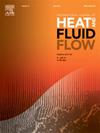Restricted nonlinear simulations of flow over riblets: Characterizing drag reduction and its breakdown
IF 2.6
3区 工程技术
Q2 ENGINEERING, MECHANICAL
International Journal of Heat and Fluid Flow
Pub Date : 2025-05-27
DOI:10.1016/j.ijheatfluidflow.2025.109862
引用次数: 0
Abstract
The restricted nonlinear (RNL) model is employed as low-order representation of turbulent flow over riblets at . Comparisons with direct numerical simulations (DNS) verify the ability of the model to accurately capture low-order statistics, as well as trends in drag-alteration and secondary motion as a function of riblet geometry and spacing. We demonstrate the ability of the RNL model to reproduce additional flow features by decomposing the roughness function to isolate contributions from the total stress and comparing its predictions to DNS data. An analysis of the spectra of Reynolds shear stress shows that the RNL model captures Kelvin-Helmholtz-like rollers linked to riblet drag reduction breakdown but slightly over predicts the total stresses. The reproduction of the overall trends in stresses and flow features linked to the breakdown of riblet induced drag-reduction suggests that the nonlinearity and scale interactions retained in the RNL system are adequate to capture the key mechanisms underlying turbulent flow over a range of riblet geometries. These results also indicate that examining the limitations of the model may provide insight into the critical nonlinear interactions underlying drag alteration due to riblets.
波纹流动的受限非线性模拟:表征减阻及其破裂
采用限制非线性(RNL)模型作为Reτ≈395处波纹上湍流的低阶表示。与直接数值模拟(DNS)的比较验证了该模型准确捕获低阶统计数据的能力,以及作为纹波几何形状和间距函数的阻力变化和二次运动的趋势。我们证明了RNL模型通过分解粗糙度函数来分离总应力的贡献,并将其预测与DNS数据进行比较,从而再现额外流动特征的能力。对雷诺剪切应力谱的分析表明,RNL模型捕获了与波纹减阻破裂相关的类开尔文-亥姆霍兹滚子,但对总应力的预测略过。与裂缝破裂引起的减阻有关的应力和流动特征的总体趋势的再现表明,RNL系统中保留的非线性和尺度相互作用足以捕捉一系列裂缝几何形状下湍流的关键机制。这些结果还表明,检查模型的局限性可能有助于深入了解由波纹引起的阻力变化的关键非线性相互作用。
本文章由计算机程序翻译,如有差异,请以英文原文为准。
求助全文
约1分钟内获得全文
求助全文
来源期刊

International Journal of Heat and Fluid Flow
工程技术-工程:机械
CiteScore
5.00
自引率
7.70%
发文量
131
审稿时长
33 days
期刊介绍:
The International Journal of Heat and Fluid Flow welcomes high-quality original contributions on experimental, computational, and physical aspects of convective heat transfer and fluid dynamics relevant to engineering or the environment, including multiphase and microscale flows.
Papers reporting the application of these disciplines to design and development, with emphasis on new technological fields, are also welcomed. Some of these new fields include microscale electronic and mechanical systems; medical and biological systems; and thermal and flow control in both the internal and external environment.
 求助内容:
求助内容: 应助结果提醒方式:
应助结果提醒方式:


